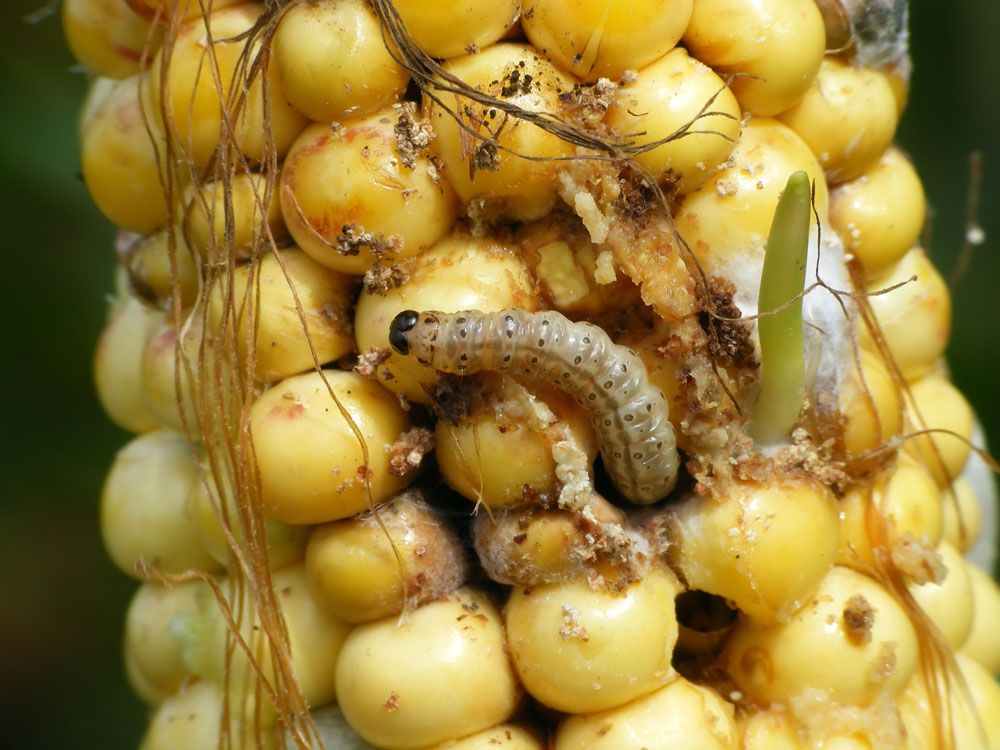
European Corn Borer – Ostrinia nubilalis
European corn borer (Ostrinia nubilalis)
Latin Name: Ostrinia nubilalis
Common Name: European corn borer
Appearance:
The European corn borer (Ostrinia nubilalis) is a form of a distributed moth. The European corn borer larva is dull white with tiny brown dots and a black head in its first instar.
- When originally laid, the eggs are relatively flat, about 1 mm in diameter, white, but eventually yellow. Just before hatching, the larva’s black head may be seen. The eggs are placed in a pile, overlapping like roof tiles. Thirty eggs per egg mass are the average number of eggs per egg mass.
- The larvae have such a body that is purplish-brown to brownish, with black spots at the base of the hairs, and can reach a length of 25 mm. The colour of the head ranges from brown to brownish-black.
- The pupae can grow up to 2 cm long and range in colour from mild reddish brown to dark reddish brown. The adult larva measures about an inch long and is pale to grey.
- Adults have pale yellowish to olive-brown forewings with irregular purplish-grey patterns and 22-32 mm wingspan—light grey with darker marks on the hindwings.
Host plants:
The European corn borer has a wide range of hosts. It may live on various cultivated plants and weeds, although maize is its preferred host. Plant size does, however, affect host selection.
Territory:
It is found throughout Europe, North Africa, and North America.
Damages caused by European corn borer:
Vertical rows of holes in immature leaves, induced by larval feeding, indicate European corn borer assault early. Tunnelling by larvae weakens the stalks, causing them to break under windy conditions. Plants that have been badly assaulted are smaller and yield fewer kernels per year. The insect’s larval feeding destroys the maize stem’s vascular tissue, rendering it more vulnerable to assault.
Description about Leafminers:
Leafminer adults are tiny flies with yellow sections on their thorax, legs, and abdomen. They are 0.1 inches (2.5 mm) long, black to blue, and have yellow portions on their thorax, legs, and abdomen. There is generally a visible yellow patch at the base of the wings. The tiny white eggs are hidden behind the leaf’s epidermis and develop in 4 to 6 days. Pupation takes happen underground or in mines. During the summer, the life cycle takes around 23 days. Every year, three to five generations pass. Leafminers infrequently afflict beans. The majority of the time, their quality deteriorates after the harvesting season. Large whitish blotches or, in the case of serpentine leafminers, thin, white, winding paths into the leaf’s core occur from the larvae eating between the upper and lower leaf surfaces.
Life history and Habits:
Inside cornstalks and crop leftovers, the European corn borer overwinters as a fully-fledged larva. The overwintering larvae pupate in the spring. Adult moths emerge in mid-May, mate, and deposit eggs on the undersides of maize leaves in the stalks’ lowest two-thirds. The hatching larvae eat on the leaf surface, and then migrate inside the whorl, where they continue to feed on leaf tissue. The larvae leave the whorl and tunnel through the stalk to reach the third instar. Adults emerge eight days after the mature larvae pupate within the corn stem. In July, these freshly occurred adult moths mate and deposit eggs for the second generation. When they reach the third instar, the second-generation juvenile larvae begin eating in the leaf axils or ear tips before migrating into the stalk, burrowing into the ear tip, or ear shanks. These second-generation larvae burrow into the branch during the winter and enter diapauses (pupal stage).
